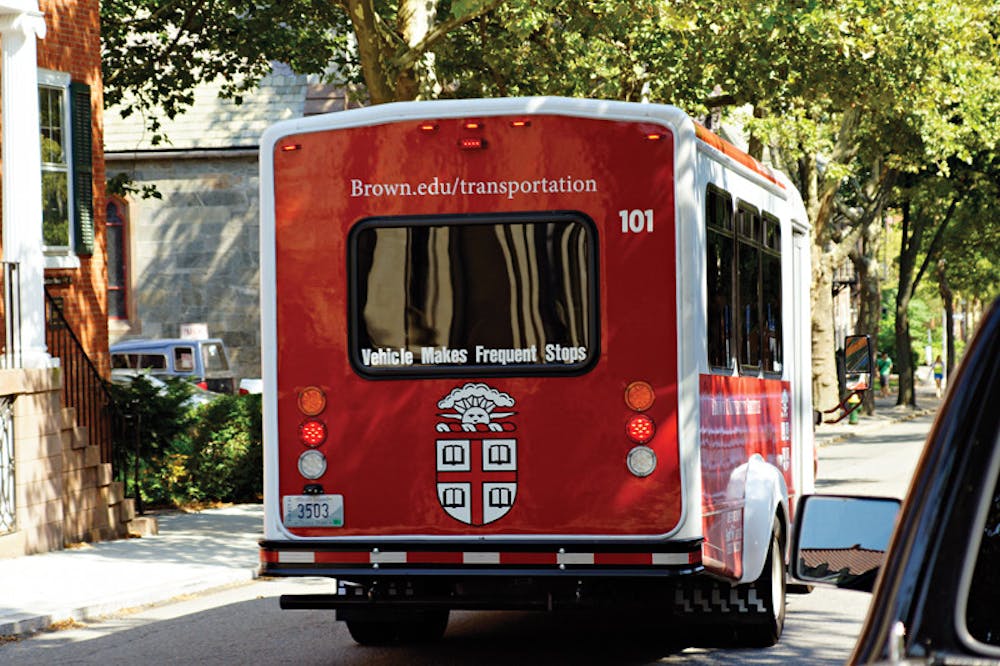The University will soon launch a pilot program to expand Brown OnCall, the nighttime shuttle service currently available only to students living off-campus, President Christina Paxson wrote in a community-wide email Wednesday.
A task force headed by Executive Vice President for Policy and Planning Russell Carey ’91 MA’06 will also be formed to further examine issues of campus safety and how to deter crime.
The campus has recently seen a series of armed robberies that “motivated” action, Carey said.
“There’s no question there’s concern from parents, from students, members of the community,” he said. “And we’re seeking to respond to that.”
Brown OnCall is currently only available to transport registered students to and from off-campus residences. Once the changes are implemented, “all community members with a Brown ID” will be able to call for the shuttle service, according to the email. More information about this program is forthcoming, but Carey said the changes will happen “very quickly.”
The University has been “trying to really balance convenience and transportation needs with safety and security for a long period of time,” Carey said.
Brown OnCall is one of a variety of shuttle services the University provides.
The Brown University Shuttle replaced SafeRide this summer, following the University’s switch to service provider First Transit Inc. from University Shuttle LLC, which owned the rights to the “SafeRide” name, The Herald previously reported. The Undergraduate Council of Students had input in deciding the new name, but it was ultimately chosen by administrators of the shuttle service, Carey said.
The Brown OnCall expansion will be an investment, and the University will “make assessments about the kind of resources necessary to support a more robust program going forward,” said Marisa Quinn, vice president of public affairs and University relations.
Additional changes to the shuttle program discussed by the task force could include increasing and expanding BUS shuttle routes, he said. Other possible areas of interest for the task force will include increasing community awareness of safety issues, bolstering campus surveillance and developing “tighter integration between Brown Shuttle, Brown OnCall and the Safewalk Program,” according to the email.
The Department of Public Safety has increased its presence on campus recently and has been making efforts to decrease crime in other ways.
There will be more “yellow jacket” security officers who stand guard at “highly visible fixed posts around campus,” according to the email. The security officers are not armed and do not have powers of arrest, said Chief of Police for DPS Mark Porter.
Beginning Thursday evening, the number of these guards around campus will increase, Carey said. DPS has also placed more detectives on evening shifts, Porter said.
Providence Police Department officers have also stepped up their presence in the Thayer Street area, the Providence Journal reported Aug. 29. In addition to the “six or seven uniformed police officers” normally patrolling Districts 8 and 9, the area that encompasses Thayer, two additional plainclothes officers have been added for Thursday, Friday and Saturday evenings, Deputy Police Chief Thomas F. Oates III told the Journal. They will be covering the East Side neighborhood from 11 p.m. to 3 a.m. those days.
DPS collaborates significantly with Providence Police in patrolling the area around campus, Porter said. In addition to joint patrol teams with an officer from each department, representatives of the two meet weekly to discuss crime trends and strategies, and the departments share a joint substation in the Jewelry District and sometimes train together.
The challenges of an urban campus make eliminating crime impossible, Carey said. “We’re not in a remote rural area — we’re not behind a wall,” he said.
Both Porter and Carey said that awareness and education are crucial in reducing crime. “Keeping the students well-informed and engaged about their safety is a top priority for DPS,” Porter wrote in a follow-up email to The Herald. Students can avoid becoming “easy targets” by staying aware of their surroundings, Carey said. He and Porter also encouraged students to take advantage of services like BUS and Safewalk, which will resume full service on Sunday with its normal hours of 9 p.m. to 2:15 a.m.
Students are aware of the current crime trends on campus, and some expressed concerns about their safety in the wake of recent incidents.
“I’ve heard more about violence in the past few months than way back to my freshman year — it’s gotten more serious,” said Trevor Young ’15.
Some students said they practice certain habits to feel safer when walking around campus at night, such as walking in groups or not using their cell phones. Young said he no longer wears headphones when walking at night.
Paulina Tarrant ’16 said she would not walk alone in certain areas after dark, but she added that she generally feels safe near the Main Green and has noticed the increase in DPS personnel.
Many students said they’d still like to see the University respond more seriously to crime around campus.
“We shouldn’t have to feel we can’t walk home by ourselves from the library at night,” said Nicole Salvador ’15.
— With additional reporting by Maggie Livingstone

ADVERTISEMENT




